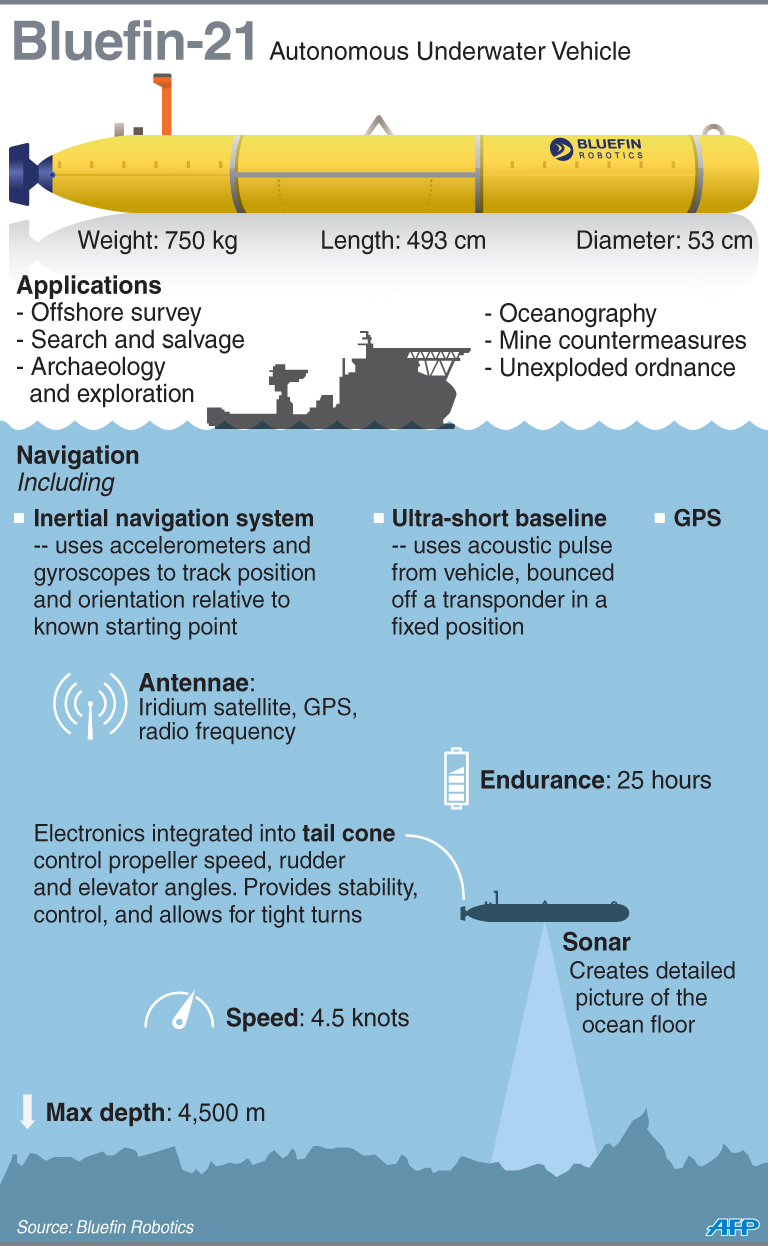Mini-sub set to scour ocean depths for MH370

A Bluefin Robotics submarine is being placed onto the deck of a boat. Bluefin Robotics shipped a version of their submarine to help locate the missing Malaysian Airlines Flight MH370 by using its side-scan sonar. (AP/Scott Eisen)
PERTH, Australia: Australia decided on Monday to deploy a mini-submarine to scour the unmapped Indian Ocean seabed for Malaysian jet MH370 at a daunting depth of 4,500 metres (15,000 feet), ending the search for black-box signals.
Angus Houston, who heads the Joint Agency Coordination Centre, also revealed that an oil slick had been sighted in the area of the search led by the Australian vessel Ocean Shield far off Perth.
"Ocean Shield will cease searching with the towed pinger locator later today and deploy the autonomous underwater vehicle Bluefin-21 as soon as possible," Houston said, adding it could enter the water later Monday.
"We haven't had a single detection in six days so I guess it's time to go underwater," he told a news conference.
"We anticipate deploying it this evening."
The US Navy said the vehicle would deploy at 5:00 pm Perth local time (0900 GMT), but did not immediately confirm the launch after the specified time.
"(It) will descend to a depth of between 4,000 and 4,500 metres, approximately 35 metres above the ocean floor," the navy said in a statement.
"The AUV will spend up to 16 hours at this depth collecting data, before potentially moving to other likely search areas," it added.

Malaysia Airlines Flight MH370 went missing on March 8 en route from Kuala Lumpur to Beijing with 239 people on board. The reason why the plane came to crash in the southern Indian Ocean remains a mystery.
So far no debris has been found despite an enormous search involving ships and planes from several nations. But Houston said about two litres of the newly spotted oil slick had been collected for testing.
"I stress the source of the oil is yet to be determined but the oil slick is approximately 5,500 metres downwind... from the vicinity of the detections picked up by the towed pinger locator on Ocean Shield," he said.
It would be a number of days before the oil could be conclusively tested ashore, but Houston said he did not think it was from one of the many ships involved in the search.
"It's very close to where the transmissions are coming from and we'll investigate it and that will take a little bit of time, given that we're in the middle of the Indian Ocean.
Houston emphasised that it was 38 days since the Boeing 777 vanished and the batteries powering the black box tracker beacons had a life of only 30 days.
Ocean Shield has detected four signals linked to aircraft black boxes, helping to narrow down the vast search zone. But the last confirmed ping came on Tuesday last week and officials suspect the batteries are now dead.
The retired air chief marshal stressed the enormous difficulties in working at great depths in such a remote location.
"This is an area that is new to man," Houston said, expecting to find a lot of silt.
"It's not sharply mountainous or anything, it's more flat and almost rolling, but we understand... that part of the India Ocean has a lot of silt on the bottom.
"And if we have silt on the bottom, that can be quite layered, quite deep and that will complicate how things are on the bottom. It's around 4,500 metres."
The Bluefin-21 is equipped with side-scanning sonar and will initially focus on 40 square kilometres (15 square miles) of seabed in the vicinity of the detected signals.
But Houston explained that the US-made vessel operates slowly, with each mission taking a minimum of 24 hours to complete.
The device needs two hours to reach the bottom, where it will work for 16 hours producing a high-resolution 3D map before surfacing in another two hours.
Downloading and analysing data requires a further four hours.
But while the mini-sub could take the search a step closer towards visually identifying any wreckage, Houston repeated his longstanding note of caution that nothing was guaranteed.
He noted that after Air France Flight AF447 crashed in the Atlantic Ocean in June 2009, it took nearly two years to retrieve the black boxes from a depth of 3,900 metres.
"However, this is the best lead we have and it must be pursued vigorously. Again I emphasise that this will be a slow and painstaking process."
The Bluefin-21, a 4.93-metre long sonar device, weighs 750 kilograms and can operate down to 4,500 metres -- roughly the depth of the ocean floor where the pings were detected.
Houston also said the search for floating material from the plane would end in the coming days.
What the stars mean:
★ Poor ★ ★ Promising ★★★ Good ★★★★ Very good ★★★★★ Exceptional
Latest News
More News
- 72 nations sign landmark Hanoi cybercrime convention (October 26, 2025 | 18:00)
- UN Secretary-General commends Vietnam’s global leadership (October 26, 2025 | 09:00)
- APEC finance ministers convene to tackle regional challenges (October 22, 2025 | 17:31)
- Rewiring global trade: ASEAN’s rise as supply chain hub (October 17, 2025 | 11:40)
- Vietnam attends first World Nuclear Week Forum in Russia (September 26, 2025 | 10:50)
- Vietnam attends 69th session of IAEA General Conference (September 16, 2025 | 10:00)
- ADB, WB pledge over 12 billion USD for ASEAN power grid, renewable energy projects (August 15, 2025 | 14:18)
- Lowy Institute proposes AI-based tobacco control solutions for ASEAN (August 15, 2025 | 14:14)
- Cloud computing policy to position Malaysia as regional hub by 2030 (August 15, 2025 | 14:11)
- Thailand, Cambodia suffer numerous cyber attacks (August 05, 2025 | 16:19)


















 Mobile Version
Mobile Version